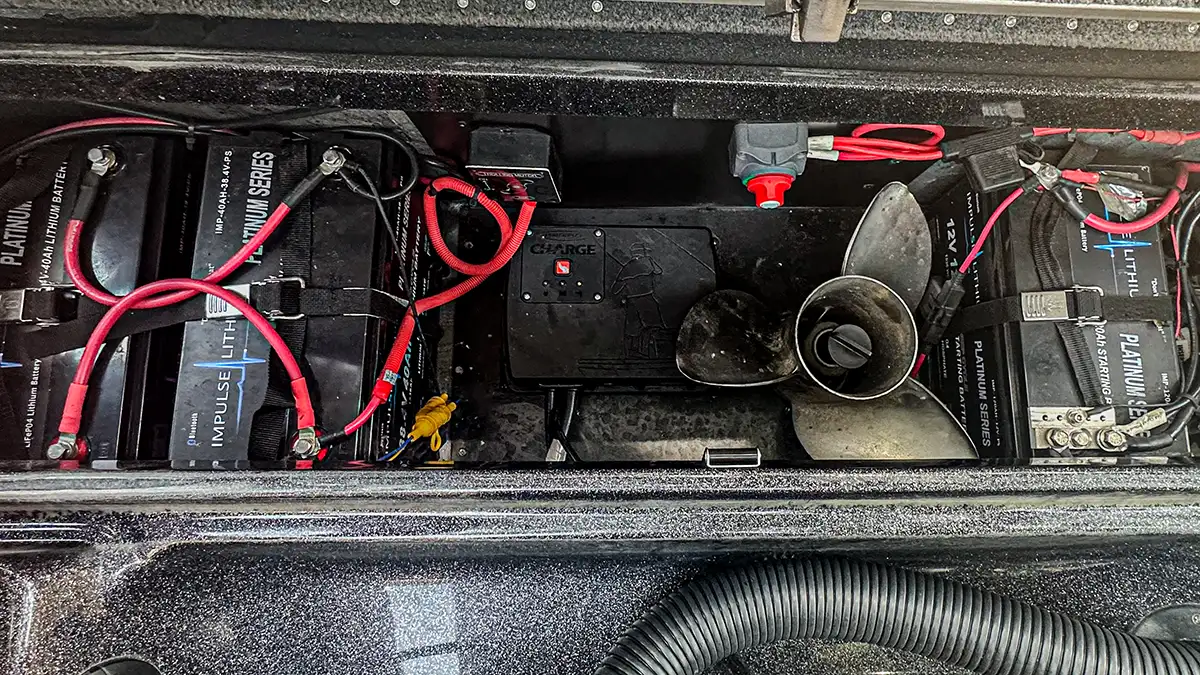Warning: Undefined variable $k in /home/nginx/domains/wired2fishcom.bigscoots-staging.com/public/wp-content/themes/understrap-child-0.6.0/functions.php on line 984
Warning: Undefined variable $k in /home/nginx/domains/wired2fishcom.bigscoots-staging.com/public/wp-content/themes/understrap-child-0.6.0/functions.php on line 987
One of the hottest topics in the fishing world is lead acid vs. lithium batteries. There are tons of people who vouch for both sides, and will argue to the death over which option is the better choice. I have ran both lead acid and lithium batteries over the last several years, and have gained a good understanding of the pros and cons of each type of battery.
In my previous boat, I ran a lead-acid system that included two 12-volt cranking batteries than ran my boat and graphs, along with two 12-volt deep cycles that ran my trolling motor. I charged these batteries using a Minn Kota 3-bank on board charger. In my current boat, I switched over to all lithium batteries. This includes one 12.8-volt, 120-amp hour Platinum Series Impulse Lithium cranking battery. This battery runs my boat and all five of my graphs. I also have two 36.8 volt, 40-amp hour Platinum Series Impulse Lithium batteries for my deep cycles. These batteries are ran in parallel, and are used strictly for my trolling motor. I charge all these batteries using the Power-Pole Charge on board charger.

ADVANTAGES OF IMPULSE LITHIUM BATTERIES
The two types of batteries I run in my current boat are the 12.8 volt, 120 amp hour Platinum Series Impulse Lithium cranking battery, and the 36.8 volt, 40 amp hour Platinum Series Impulse Lithium battery. Both of these batteries come equipped with a bluetooth feature allowing you to check your batteries charge, voltage, current and temperature straight from your smartphone.
These batteries are also backed by a 10-year warranty, which means you will never have to buy another battery again for at least 10 years. One of the biggest deterrents for people wanting to purchase lithium batteries is the price tag. However, when I was using lead acids I was having to replace my batteries basically every season. This quickly surpassed the cost of investing in a lithium battery that can last a decade or more, and was ultimately the main reason for me switching over to a lithium setup.
These batteries are also far lighter than your typical lead-acid battery. The average 12-volt weighs upwards of 50 pounds. This means that if you are running a five-battery, lead-acid setup, the weight of your entire battery system would be upwards of 250 pounds. The standard Impulse Lithium battery weighs around 27 pounds depending on the model. You are also able to use far less batteries compared to running lead acids given the high performance of these lithiums. I run three Impulse Lithium batteries that all together weigh around 90 pounds. This decreased the weight in my boat by around 160 pounds which leads to better hole shot and overall speed of the boat.

PERSONAL EXPERIENCE WITH IMPULSE LITHIUM BATTERIES
I’ve been running Impulse Lithium batteries for about four years now. I’ve noticed a few features about these batteries that have really enhanced my boats performance as well as my overall enjoyment on the water. The biggest difference I’ve noticed is my overall battery life. When I used to run lead acids, I would often deal with my trolling motor dying towards the end of the day, as well as my graphs getting low voltage due to low battery. If I fished much longer than 8 hours, my batteries would really start to deplete, which added a whole new level of stress to tournament fishing.
Since switching over to lithiums, I no longer have to worry about my batteries dying after a day’s use. I can go upwards of three full days without ever having to charge my batteries. What’s even more impressive is that I’m running five graphs with Lowrance Active Target 2 and Hummingbird Mega 360 all day long. This amount of electronics pulls a ton of power, however, I’m still able to power all of these graphs using just one 12-volt lithium battery. This also frees up a lot of space in the back of my boat to store other necessities such as tools or a spare prop.
Another advantage over lead acids I’ve noticed is that your batteries run on 100 until they die. A lead acid battery slowly diminishes in performance as the battery dies, causing your trolling motor to gradually slow down throughout the day. However, lithium batteries run as if they are fully charged until they are completely dead.
This is a great feature that allows you to fish efficiently all the way until your batteries die. While I am a big fan of this feature, it is important to keep an eye on your battery life if you know your batteries are close to dying. There is no telltale sign that your lithiums are dying since they continue to perform at maximum capacity until they are completely dead.
If you’re looking for the most reliable battery system available, lithium batteries are a great addition to your boat. While the price point is steeper than the typical lead acid battery, it quickly makes up for it with a 10-year warranty and much higher performance. I’ve ran Impulse Lithium batteries for the last four years, and I can safely say I would recommend them to anyone looking for a reliable, high performing set of batteries. We have also included them in our article on the best lithium marine batteries.












